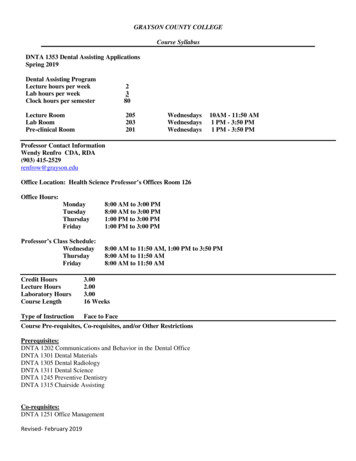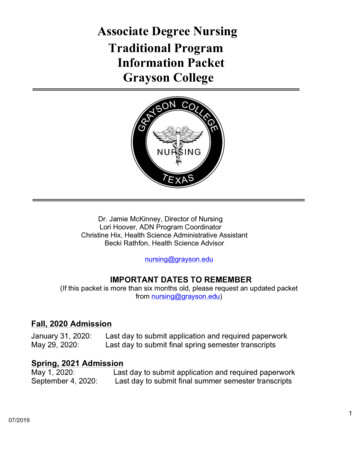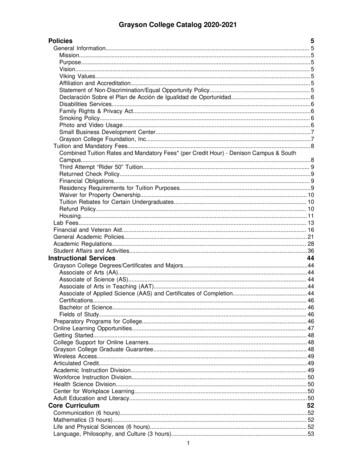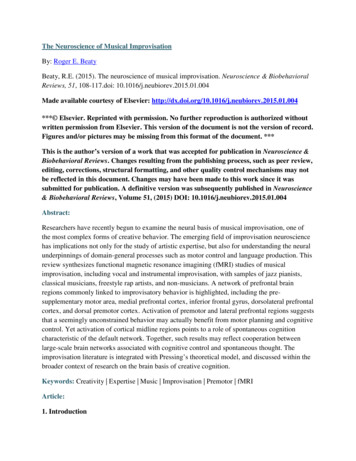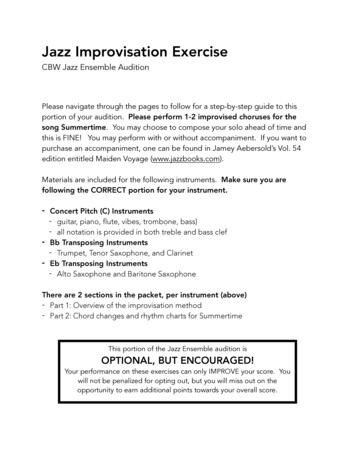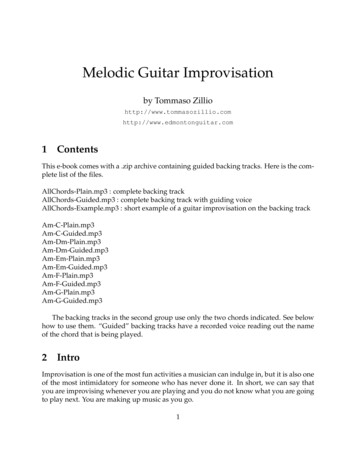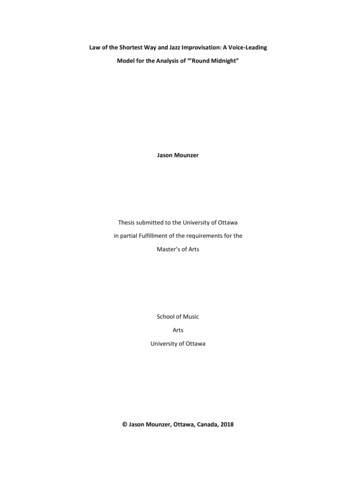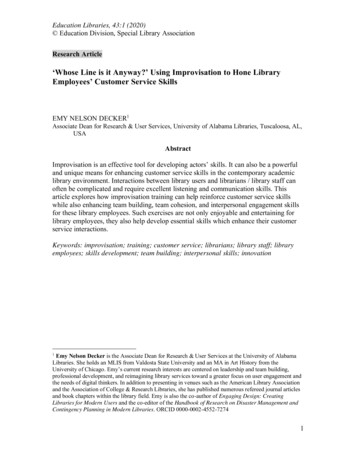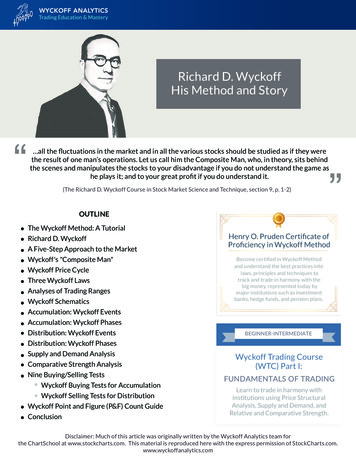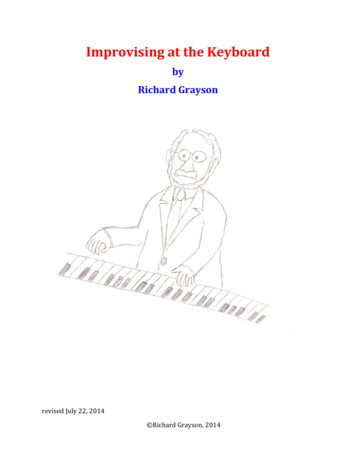
Transcription
y22,2014 RichardGrayson,2014
2
ImprovisingattheKeyboardTable of ContentsPageIntroduction4Melodic Shapes5Ch. 1: Pentatonic scale improvising6Ch. 2: Improvising with one chord10Ch. 3: Improvising with four basic chords12Ch. 4: Embellishing your melody15Ch. 5: Other basic 8-measure progressions17Ch. 6: Repeating Progressions20Ch. 7: ABA improvisation26Ch. 8: Progressions for everyday practice31Ch. 9: Modulation to closely related keys35Ch. 10: Counter-melodies (counterpoint)38Ch. 11: Pan-diatonic improvisation39Ch. 12: Stylistic improvisation44Ch. 13: Blues52Ch. 14: Popular music55Ch. 15: More progressions to practice63Ch.16: Electronic organ versions of selected items673
Introduction:This book is intended to introduce keyboard players to improvisation in styles thatderive primarily from European Classical music. The purpose is to allow them tocreate meaningful, expressive music using relatively simple materials, often thosethey have already learned in harmony courses, or are familiar with from piecesthey have played. When musicians feel free to create melodies of any shape orrhythm that fit the harmonic accompaniment, the result is greater variety andexpressiveness. Most importantly, when they create spontaneously, there is a directconnection to their feelings, sometimes called the “unconscious,” which can makethe experience deeply meaningful. Mastery of even basic materials will allow thisexperience to occur.The basic approach of this method is to generate all melodies from theaccompanying harmonies. I have avoided making rules for good, or eveninteresting, melodies. Both beginners and advanced players, including thosewithout a "gift" for improvising, usually come up with satisfying results just byplaying with these materials. The advantage of using simple materials is thatplayers are freer to let their fingers lead them intuitively, since many possibilitiesworks adequately. Students usually progress quickly from playing random notesthat fit the harmony, to creating meaningful melodies from these notes. If studentsfeel the need for guidance, they can find many kinds of melodic shapes in thestandard repertoire. I have found, however, that the best results come fromalternating phrases with a more experienced player.Another important aspect of this approach is that students do not learn a fixedrepertoire of melodies. From the beginning, they are invited to create melodies ofdifferent shapes and rhythms. Complexity is gradually introduced through nonchord tones, different kinds of accompaniments, new chords, modulations, andABA forms.In addition to “The Blues,” there is also a section on playing popular songs fromlead sheets. This is a very enjoyable skill, and will introduce classical musicians tothe wonderful repertoire of popular songs from the 1910's through the 1950's andbeyond. The method for improvising melodies on these tunes is the same as themethod for classical improvisation: namely, to create melodies from the harmoniesthat are indicated in the lead sheet.4
Melodic Shapes:We all respond to beautiful, inspired melodies, and as improvisers we would like tocreate them ourselves. Although it is possible to analyze a successful melody andsee what contributes to its beauty, it is almost impossible to establish rules forcreating one. In general, melody looks for a balance between unity (similarity) andvariety (difference). If you find you are using too much of the same note orrhythm, add some variety. Conversely, if every measure has too many differentshapes and seems unrelated, you need more unity in your choice of pitches, andmaybe more importantly, rhythms.From the beginning of your improvisation studies, think of your melodies asshapes based on the notes of your harmony. This is important because it avoids themain difficulty for new improvisers: how to find a harmony that fits your melody.With the use of different shapes (including repeated notes) and different rhythms,the combinations using only chord notes are endless. You will see basic examplesof this in "Chord and Melody Improvising on the Piano."No matter howcomplicated your melodies become through the use of non-chord (decorating, orembellishing) tones, they will always make musical sense if you are aware of theharmony.Of course, there is a strong connection between melody and harmony. A dullmelody can be made interesting with good harmony, and an interesting melody canmake simple harmony beautiful. For example, if heard by itself, the melody ofChopin's Prelude no. 4 in E minor is rather boring, but with its wonderfulharmonies it has great meaning and intensity.At the other extreme, Chopin's "Berceuse" is an example of a beautiful melodywhich uses only two chords, I and V7, for almost the entire piece.IV7IV75
Chapter 1: Pentatonic scale improvising.We will begin by improvising melodies using only the black notes of the piano.These notes create a Pentatonic (5-note) scale that is easy to see, and can beaccompanied effectively by just one or two chords.The "major mode" version of the scale is F# G# A# C# D#, with F# as the primarynote, or “tonic.”The "minor mode" version of the scale is D# F# G# A# C#, with D# as the primarynote, or “tonic.”The accompaniments will help to support whichever mode you use. Your job is tocreate an interesting and varied melody to the accompaniment, preferably in 8measure phrases divided 4 4. This will tend to happen naturally, either rightaway or very soon. Please see the pentatonic melody examples if you would likesome guidance.You have been given four different versions, each in “A B A” form. Each versionuses a different arrangement of duple, triple, major and minor:1. Major-Minor-Major pentatonic in duple meter.2. Major-Minor-Major pentatonic in triple (compound duple) meter3. Minor-Major-Minor pentatonic in duple meter.4. Minor-Major-Minor pentatonic in triple (compound duple) meter6
The accompaniments assume that there are at least two players: one to accompanyand one to improvise a melody. At the end of 8 measures (or perhaps 16), theplayers switch roles.If you do not have a second player, there is a left hand accompaniment at thebottom of the musical examples.If there are several players and instruments, give each person a chance to play themelody while everyone else plays the accompaniment.Give both the accompaniment and the improvised melody a "character" throughthe use of tempo and dynamics: perhaps happy, sad, aggressive, etc., so that theresult will sound expressive, and not like an exercise.Suggestion for the melody: sometimes play in octaves using right and left hand.Advanced players can use both hands to create two-voice counterpoint.7
Pentatonic improvising in ABA formOne person plays the accompaniment, one person improvises a pentatonic melody. If you like, you canexchange melody/accompaniment roles every 8 or 16 measures. Let the person playing the melody use the lefthand to hand signal 1 or 2, and a "fist" to indicate the End. Try different tempos and dynamics. Two measuresof accompaniment makes a good "intro."Major œœ#? # # # # 42 ‰ œœJ##1.œœœœ‰ J1 (repeat at leastDuple? # # # # # 42# œ8 times)œMajor œœœœœœœœ. . ‰ œJ ‰ œJ . . ‰ œœJœœœœ‰ J . .œ.Minor2 (repeat at least8 times)œœ. .1 (repeat at least8 times)œEndMinorMajorœœœœœœœœœœ? # # # # # 68 ‰ œ œ ‰ œ œ . . ‰ œœ œ ‰ œœ œ . . ‰ œ œ ‰ œ œ .#Major#2.1? #### # 6# 8 œ.Triple (compound duple)? # # # # # 2 ‰ œœœœ# 4J#3.Minor1Duple? # # # # # 42#œœ. .2œ.œ. .1œ.œ. .End .œœœœ‰ Jœœ. . ‰ œœJœœœœ‰ Jœ. . ‰ œœœJœœœœ‰ J . œ. .œ. .œ.Major2œMinor1œEnd MajorMinorœœœœ œœœœœœœ ‰œ . . ‰ œœœ œ ‰ œœœ œ . .? # # # # # 6 ‰ œ œ ‰ œ œ . . ‰# 8#4.Minor? # # # # # 68#1Triple (compound duple)œ.œ.? # # # # # 2 œ œœœ œ œœœ# 4. .2œ.Left hand accompaniment for solo pentatonic improvisingMajorMinorDupleFor smaller hands:? # # # # # 42 œ œœ œ œœ#. .œ.œœœ œœ œ œœMajor6 œ œœœ8J1œ.j œœœœTriple (compound duple)68 œ œœJœ œœ œ œœ8j œœ œ.œ.œœ œœJMinorœ œœJEnd .j œœœœj œœœ
Pentatonic Melody Examples#### # 2& # 4 œ#### # œ& #œœœœœœduple meter# # # # #Minor,2& # 4 œ œ œ œ#### #& #œ.œœœMajor, duple meterœœœœœ œ œ œœœœœ.œœ.œ œœœœœœœœœœœœœœœœœ.œ œœœœ.œ œœœ#### # 6& # 8 œ œ œ œ œœ œ œ œJ œ œ œ œœœ#### # œ œ œ œ œ œœ œœ#œœJœ œ œ&œœ œ œJœ œMajor, triple (compound duple) metertriple (compound duple) meter# # # # Minor,#j& # 68 œ œ œ œ œ œ œ œ œ .#### # œ œ œ& # œœœJ œ œ œ2-voice counterpoint (Major, duple meter)#### # 2 œ œ& # 4 œ#### # œ& # œœœœœœ œœ œœœœœ œœœœœ œ œ œ œ œ œJœœ9jœ œ œ œ œ.œ œœ œ œ œœ œœœœœœœœRichard Graysonœ œœœœœœœ œ œ œ.œ œ œ œ.œ œ œœœ œœœœœœœJ
Chapter 2: Improvising with one chordThis chapter will allow you to concentrate on one chord at a time. It is importantto become comfortable creating different melody shapes and rhythms with just asingle chord. The end of this chapter includes practice with two chords.There is little that needs to be said about how to approach this task. The musicalexamples should answer most of your questions. Try to play each improvisation asexpressively as you can. Even very simple music can be effective when playedmusically. Give the melodies a shape as you play, and don't overpower them withthe accompaniment. Pedal each measure to sustain the accompaniment.Melodies based on the I (C major) or i (C minor) chord. I or i is called thePractice melodies based on a single chord“tonic” chord.R. GraysonPractice melodies basedon a single chordœœœœjœœœœœœj œœ3œœœœœœ œ .c&œœœ œœœ œœœ œ4 œ œ. œ œ œ œœGraysonœœR.œexample using C,E,G or C, E-flat, GexampleC major or minorœœœœœœœœœœœœœœœ œœj œ œ œ œ œ œ œ œ œœ œ œ œ œ œ 33 œœœ œœ j œ œœœ œœ œœœœ �.& c œ œœœ œ œœœ œ œœ44 œœ œ œ œœ œ œœ œ œ œœ œœ œexample using C,E,G or C, E-flat, Gexampleœœ œœ œœœœ œœ œœ œœ œœ œœ œœ œœ œœœœ œœœœ œœ œœ œœœœ œœ? ccreate3œœœœœœœœœœœœœœœœœœœ your own œmelodyœœœœœœ œœ43& c (for minor, use E-flats)4(forminor,oruseminorE-flats)Cmajorœ œ œ œ œ œ œ œ œ œ œ œ 3 œ œ œ œ œ œ œ œ?& cc œ œœ œœ œœ œ œœ œœ œœ œ œœ œœ œœ œ œœ œœ œœ 434 œ œœ œœ œ œœ œœ œ œœ œœ œ œœ œœC major or minorcreate your own melodyœœ œœ œœ œœ œœ œœ œœ œœ œœ œœ œœ œœ 3 œœ œœ œœ œœ œœ œœ œœ œœ? exampleœ œ G,œB,œD,œF œ œ œ œ œ œ œ œœ œ 4 exampleœ œ œ œ œ œ œ œ œ œ œc œ œ usingœœœœœœ. œ œ œ œ . œ œœ œœ 3 œ œœ. j œ œ œ œ.jœœœœœjœ& c (forœœ4œœminor,useE-flats)œ. œJJœœ œ œ œC(formajorminor, oruseminorE-flats)œœ œœ œœ œœ œœ . œœœœœ œ. œœjœœ œœ œœ œœ œœœ œœJexampleG7 using G, B, D, F?&cœ œ œœ œ œœ œœœœ.œ œ œ œJ? ccreateœœœœ yourœœœœ œœœœown melodyœœœœ œœœœ œœœœœœ&c œG7œœœœœ œœœ œœœœœ œœœœœ œœ œ œ œexample3443 œ œœœœœœœœœœ œœœœœœœ. œœœ j œ œœœœœœ. œœœœj œ œœœœœœœœœœœœœ œ œœœœ œœœown œmelodyœœ œœœœœœœ œœœœ œœœœ œœœœ œœœœ 4create3 œyourœœ34 œœ 10œ œ œ œœœœœ œœœœœœœœœ œœœœ
&c4œœ œœ œœ œœ œœ œœ œœ 3 œœ œœ œœ œœ œœ œœ œœ œœ? c œ œœœ œœœ œœœ œ œœœ œœœ Melodiesœ œ œ œbasedœ œ onœ theœ œV7 (G7)œ œ œ œ œ œ œ œ œ œ œ4 œ chordC major or minor(for minor, use E-flats)œ œ œ 3 exampleœœœ.œœœœœœœ 4 œ œ œ œ œ œ . j œ œ œ . œj œ œ œ œ& c œ . œj œ œ œ œ œ J œ œ . J œœ œexample using G, B, D, F? c œœœœ œœœœ œœœœ œœœœ œœœœ œœœœœœœG7&cœœœœœœœœ œœœœ œœœœ œœœœ œœœœœ43 œœœœœ œœœœœœœœœ œœœœœœœœœ œœœœœœœœœ œœœœ43create your own melodycreate your own melody? c œœœœ œœœœ œœœœ œœœœ œœœœ œœœœ œœœœ œœœœ œœœœ œœœœ œœœœ œœœœ 43 œœœœ œœœœ œœœœ œœœœ œœœœ œœœœ œœœœ œœœœœœœœœœœœ& 43G7Practice with two chords:œ œœ œ? 43 œ œœ œœ œ œœ œœœœœœ œœœœœœCCG7(for minor, use E-flats)G7œœœœœ œœœœœ œ œœ œœœCG7œœœœœ œœœœœ œœœœ œ œœ œœœG7œœœœCIf you find that your melodies don’t connect well at the chord changes (C to G7, orG7 to C), consider these suggestions:Suggestions for smooth melody shapes when changing chords.1. Repeat G(foras Cthe“shared”melody note between the two chords.minor,use E-flats)2. Use a note that is close (a 2nd or a 3rd) to a note in the new chord.3&4œœœœœœ? 3 œ œ œœ4C& �œœœœœœ!œœœœœ œœœ œ œC!!
Chapter 3:Improvising with four basic chords.The four basic chords are I, IV, V, and V7. You were introduced to I and V7 inChapter 2. Note that V7 is really an intensification of V and not a completelyseparate chord. However, you will get more variety if you learn them separately,and not assume that all V chords can be replaced by V7.If Roman numerals (numbers) are new to you, it should not take you long to learnthem. Some older clocks and watches used them instead of Arabic numerals. Ofcourse, only the first seven are used, because they correspond to the notes of ascale:I 1, II 2, III 3, IV 4, V 5, VI 6, and VII 7Here are two important things to know:1. "I" always represents the tonic (1st, or primary, chord) of whatever keyyou are in. It actually indicates a "triad" on that note, namely 1, 3, and 5 of thescale. Each Roman numeral represents a triad on that note of the scale.2. While it is not universal, most current music theory books use upper caseRoman numerals for Major (and Augmented) triads, and lower case Romannumerals for Minor (and Diminished) triads. This will be helpful when you readprogressions which show only Roman numerals.For example, iv Minor, V Major, iio Diminished, III Augmented.You have already been introduced to I and V7. Now you will be introduced to IVand V, the two remaining chords that will allow you to create many basicprogressions. The first measures (right hand) of IV and V show the normal melodyrange of chord notes. The second measures of IV and V give a short melodicexample. The left hand plays a simple accompaniment.12
Chord
method for classical improvisation: namely, to create melodies from the harmonies that are indicated in the lead sheet. 4. Melodic Shapes: We all respond to beautiful, inspired melodies, and as improvisers we would like to create them ourselves. Although it is possible to analyze a successful melody and see what contributes to its beauty, it is almost impossible to establish rules for creating .


